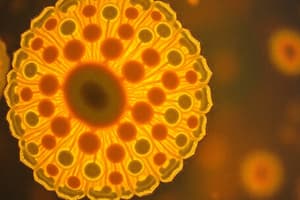Podcast
Questions and Answers
What is the primary function of flagella in prokaryotic cells?
What is the primary function of flagella in prokaryotic cells?
- Organizing cytoplasm
- Motility and chemotaxis (correct)
- Cell shape maintenance
- Protein synthesis
What distinguishes eukaryotic cells from prokaryotic cells?
What distinguishes eukaryotic cells from prokaryotic cells?
- Membrane-bound organelles (correct)
- Presence of a nucleoid
- Presence of ribosomes
- Lack of a cell wall
What is the function of plasmodesmata in plant cells?
What is the function of plasmodesmata in plant cells?
- Movement of cytoplasm
- Communication between adjacent cells (correct)
- Support for the cell structure
- Synthesis of proteins
Which of the following describes archaeal organisms?
Which of the following describes archaeal organisms?
Which organelle was newly discovered and is responsible for converting nitrogen gas for cell growth?
Which organelle was newly discovered and is responsible for converting nitrogen gas for cell growth?
Where is DNA typically found in prokaryotic cells?
Where is DNA typically found in prokaryotic cells?
What allows the movement of cytoplasm and vesicles in a cell?
What allows the movement of cytoplasm and vesicles in a cell?
Which of the following is NOT a characteristic of prokaryotic cells?
Which of the following is NOT a characteristic of prokaryotic cells?
Which stage of mitosis is characterized by the centrioles moving toward opposite sides of the cell while the nuclear membrane begins to disappear?
Which stage of mitosis is characterized by the centrioles moving toward opposite sides of the cell while the nuclear membrane begins to disappear?
What occurs during the prometaphase stage of mitosis?
What occurs during the prometaphase stage of mitosis?
What is the primary purpose of the metaphase checkpoint?
What is the primary purpose of the metaphase checkpoint?
During which phase of meiosis does genetic recombination occur?
During which phase of meiosis does genetic recombination occur?
How many successive divisions occur in meiosis?
How many successive divisions occur in meiosis?
Which of the following statements about mitosis is incorrect?
Which of the following statements about mitosis is incorrect?
What specific role does protein kinase play during the cell cycle?
What specific role does protein kinase play during the cell cycle?
What type of cells does mitosis produce?
What type of cells does mitosis produce?
What is the result of cytokinesis following meiosis?
What is the result of cytokinesis following meiosis?
Which phase of the second meiotic division involves the separation of sister chromatids?
Which phase of the second meiotic division involves the separation of sister chromatids?
What does non-disjunction lead to in the daughter cells?
What does non-disjunction lead to in the daughter cells?
Which condition is characterized by having an extra chromosome in the 21st pair?
Which condition is characterized by having an extra chromosome in the 21st pair?
During which meiotic stage do dyads contract?
During which meiotic stage do dyads contract?
What term is used to describe a condition of having extra or missing chromosomes?
What term is used to describe a condition of having extra or missing chromosomes?
What does cytokinesis involve in animal cells?
What does cytokinesis involve in animal cells?
Which of the following conditions involves a triple X chromosome configuration?
Which of the following conditions involves a triple X chromosome configuration?
What is a common outcome associated with Trisomy 18?
What is a common outcome associated with Trisomy 18?
What is the primary driving force behind membrane formation?
What is the primary driving force behind membrane formation?
What characteristic do lipids possess that makes them amphipathic?
What characteristic do lipids possess that makes them amphipathic?
Which of the following structural aberrations involves the rearrangement of chromosomal segments?
Which of the following structural aberrations involves the rearrangement of chromosomal segments?
What is sonification used for in biochemical processes?
What is sonification used for in biochemical processes?
Which feature is commonly associated with the Habsburg family?
Which feature is commonly associated with the Habsburg family?
What type of lipids are specifically mentioned as contributing to the lipid bilayer structure?
What type of lipids are specifically mentioned as contributing to the lipid bilayer structure?
What physical abnormality is associated with Trisomy 13?
What physical abnormality is associated with Trisomy 13?
What drives the movement of particles in diffusion?
What drives the movement of particles in diffusion?
What is the definition of a concentration gradient?
What is the definition of a concentration gradient?
What happens to an animal cell placed in an isotonic solution?
What happens to an animal cell placed in an isotonic solution?
What occurs when an animal cell is in a hypotonic solution?
What occurs when an animal cell is in a hypotonic solution?
Why is osmosis considered a type of passive transport?
Why is osmosis considered a type of passive transport?
What limits the rate of diffusion inside cells after molecules enter?
What limits the rate of diffusion inside cells after molecules enter?
How does the semi-permeable nature of the cell membrane affect substance movement?
How does the semi-permeable nature of the cell membrane affect substance movement?
What is the most important substance that crosses cell membranes?
What is the most important substance that crosses cell membranes?
Flashcards are hidden until you start studying
Study Notes
Cell Structures & Functions
-
Cytoskeleton: Provides cell shape, secures organelles, and allows movement of cytoplasm and vesicles.
-
Ribosomes: Synthesize proteins.
-
Flagella: Enable movement and chemotaxis (movement in response to chemical stimuli).
-
Cilia: Short, hair-like appendages extending from the cell surface.
-
Plasmodesma: Microscopic cytoplasmic canal connecting plant cells, allowing communication between them
-
Nitroplast: Organelle discovered in marine algae that can convert nitrogen gas into a usable form for cell growth.
Prokaryotic vs. Eukaryotic Cells
-
Prokaryotic Cells: Single-celled, lack membrane-bound organelles, have a nucleoid region where DNA is found. Includes bacteria and archaea.
-
Eukaryotic Cells: Multicellular, have a nucleus containing genetic material (DNA), and membrane-bound organelles.
3 Domains of Taxonomy
- Cell Woese proposed the 3-domain system:
- Eukarya: Multicellular organisms
- Prokarya: Single-celled organisms
- Archae: Ancient bacteria, extremophiles (organisms thriving in extreme environments)
Cell Cycle & Mitosis
-
Cell Cycle: Continuous process of cell growth and division, allowing living organisms to multiply.
-
Chromosomes: Contain genetic information passed from parents to offspring, making each living type unique.
-
Mitosis: Nuclear division process resulting in two new nuclei with identical genetic information:
- Prophase: Preparatory stage – centrioles move to opposite poles, nuclear membrane disappears.
- Prometaphase: Nuclear membrane disappears completely, chromosomes become visible, spindle fibers attach to chromosomes.
- Metaphase: Chromosomes align at the metaphase plate, centromeres are attached to spindle fibers (metaphase checkpoint ensures correct spindle fiber attachment).
- Anaphase: Sister chromatids separate and move to opposite poles.
- Telophase: Chromosomes reach poles, nuclear membrane reforms around each set of chromosomes, cytokinesis follows.
- Cytokinesis: Two nuclei are compartmentalized into separate daughter cells, completing the mitotic cell division.
Meiosis & Chromosomal Abberations
-
Meiosis: Reduces genetic information, producing haploid gametes or spores, with only one set of chromosomes.
- Recombination: Exchange of genetic traits during prophase I of meiosis.
- Meiosis I (PMAT I):
- Prophase I: Similar to mitosis prophase, with recombination occurring.
- Metaphase I: Homologous chromosome pairs align at the metaphase plate.
- Anaphase I: Homologous chromosomes separate and move to opposite poles.
- Telophase I: Two haploid daughter cells with reduced chromosome number.
- Meiosis II (PMAT II): Similar to mitosis, producing four haploid daughter cells.
-
Chromosomal Aberration: Changes in chromosome structure or number.
- Nondisjunction: Failure of chromosomes to separate properly during meiosis, leading to daughter cells with an abnormal number of chromosomes.
- Aneuploidy: Condition of having missing or extra chromosomes.
- Turner Syndrome: Missing one X chromosome (XO).
- Klinefelter Syndrome: Extra X chromosome (XXY).
- Metafemale (Triple X Syndrome): Extra XX chromosome (XXX).
- Jacob’s Syndrome (Criminal Syndrome): Extra Y chromosome (XYY).
- Autosomal Aberration: Aberration affecting chromosomes 1 to 22.
- Trisomy 21 (Down Syndrome): Extra chromosome in the 21st pair.
- Trisomy 18 (Edward’s Syndrome): Extra chromosome in the 18th pair.
- Trisomy 13 (Patau Syndrome): Extra chromosome in the 13th pair.
Structural Aberration
- Deletion: Loss of a portion of a chromosome.
- Duplication: Presence of an extra copy of a chromosome segment.
- Inversion: Reversal of a chromosome segment.
- Translocation: Movement of a chromosome segment to a different chromosome.
Cell Membrane
-
Lipids: Amphipathic molecules with both hydrophilic and hydrophobic properties.
- Phospholipids: Form lipid bilayers, crucial for membrane structure.
- Glycolipids: Carbohydrate complexes helping the cell bind substances.
- Cholesterol Lipids: Provide membrane fluidity.
-
Hydrophobic Effect: Key driving force in membrane formation.
-
Sonification: Using sound waves to create artificial liposomes (vesicles).
The Habsburg Family
- Habsburg Family: European royal dynasty known for intermarriage and distinctive physical features.
- Habsburg Jaw (Mandibular Prognathism): Forward protrusion of the lower jaw, prominent in the family due to inbreeding.
Transport Across Cell Membranes
- Concentration Gradient: Difference in concentration between two regions.
- Diffusion: Movement of particles from high to low concentrations.
- Osmosis: Diffusion of water across a semi-permeable membrane.
- Isotonic Solution: Solution with solute concentration equal to the cell's internal environment, maintaining cell shape.
- Hypotonic Solution: Solution with lower solute concentration than the cell, causing water to enter the cell and potentially leading to lysis (bursting).
Studying That Suits You
Use AI to generate personalized quizzes and flashcards to suit your learning preferences.



